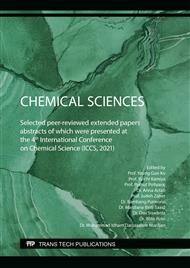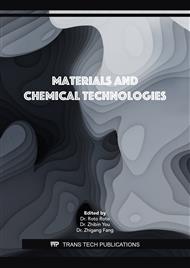[1]
S.S. Belyaev, I.A. Borzenkov, T.N. Nazina, E.P. Rozanova, I.F. Glumov, R.R. Ibatullin, M. V. Ivanov, Use of microorganisms in the biotechnology for the enhancement of oil recovery, Microbiology. 73 (2004) 590–598.
DOI: 10.1023/b:mici.0000044250.21076.0e
Google Scholar
[2]
M.S. Kamal, I.A. Hussein, AS Sultan, Review on Surfactant Flooding: Phase Behavior, Retention, IFT, and Field Applications, Energy and Fuels. 31 (2017) 7701–7720.
DOI: 10.1021/acs.energyfuels.7b00353
Google Scholar
[3]
R. Sen, Biotechnology in petroleum recovery: The microbial EOR, Prog. Energy Combust. Sci. 34 (2008) 714–724.
Google Scholar
[4]
I. Chatzis, N.R. Morrow, Correlation of Capillary Number Relationship for Sandstone., Soc. Pet. Eng. J. 24 (1984) 555–562.
DOI: 10.2118/10114-pa
Google Scholar
[5]
S. Vijayakumar, V. Saravanan, Biosurfactants-types, sources and applications, Res. J. Microbiol. 10 (2015) 181–192.
Google Scholar
[6]
H. Amani, M.M. Müller, C. Syldatk, R. Hausmann, Production of microbial rhamnolipid by Pseudomonas aeruginosa MM1011 for Ex-situ enhanced oil recovery, Appl. Biochem. Biotechnol. 170 (2013) 1080–1093.
DOI: 10.1007/s12010-013-0249-4
Google Scholar
[7]
Q. Wang, X. Fang, B. Bai, X. Liang, P.J. Shuler, W.A. Goddard, Y. Tang, Engineering bacteria for the production of rhamnolipid as an agent for enhanced oil recovery, Biotechnol. Bioeng. 98 (2007) 842–853.
DOI: 10.1002/bit.21462
Google Scholar
[8]
F.F. Habibah, R. Hertadi, A.L. Ivansyah, Y. Faozani, Sediaan bahan bionanofluida untuk diaplikasikan pada enhanced oil recovery (EOR) dan metode produksinya, P00202009815, (2020).
Google Scholar
[9]
B.A. Suleimanov, F.S. Ismailov, E.F. Veliyev, Nanofluid for enhanced oil recovery, J. Pet. Sci. Eng. 78 (2011) 431–437.
DOI: 10.1016/j.petrol.2011.06.014
Google Scholar
[10]
W. Humphrey, A. Dalke, K. Schulten, Visual Molecular Dynamics, J. Mol. Graph. 14 (1996) 33–38.
Google Scholar
[11]
B. Cherinka, B.H. Andrews, J. Sánchez-Gallego, J. Brownstein, M. Argudo-Fernández, M. Blanton, K. Bundy, A. Jones, K. Masters, D.R. Law, K. Rowlands, A.N. Weijmans, K. Westfall, R. Yan, Marvin: A tool kit for streamlined access and visualization of the SDSS-IV MaNGA data set, Astron. J. 158 (2019) 74.
DOI: 10.3847/1538-3881/ab2634
Google Scholar
[12]
Winmostar V10, X-Ability Co Ltd., Tokyo, Japan (2020).
Google Scholar
[13]
P. Hirel, Atomsk: A tool for manipulating and converting atomic data files, Comput. Phys. Commun. 197 (2015) 212–219.
DOI: 10.1016/j.cpc.2015.07.012
Google Scholar
[14]
T.G.A. Youngs, Aten - An application for the creation, editing, and visualization of coordinates for glasses, liquids, crystals, and molecules, J. Comput. Chem. 31 (2010) 639–648.
DOI: 10.1002/jcc.21359
Google Scholar
[15]
M.J. Abraham, T. Murtola, R. Schulz, S. Páll, J.C. Smith, B. Hess, E. Lindah, GROMACS: High performance molecular simulations through multi-level parallelism from laptops to supercomputers, SoftwareX. 1-2 (2015) 19–25.
DOI: 10.1016/j.softx.2015.06.001
Google Scholar
[16]
A.K. Malde, L. Zuo, M. Breeze, M. Stroet, D. Poger, P.C. Nair, C. Oostenbrink, A.E. Mark, An Automated force field Topology Builder (ATB) and repository: Version 1.0, J. Chem. Theory Comput. 7 (2011) 4026–4037.
DOI: 10.1021/ct200196m
Google Scholar
[17]
T. Raček, O. Schindler, D. Toušek, V. Horský, K. Berka, J. Koča, R. Svobodová, Atomic charge calculator II: Web-based tool for the calculation of partial atomic charges, Nucleic Acids Res. 48 (2021) W591–W596.
DOI: 10.1093/nar/gkaa367
Google Scholar
[18]
J. Gasteiger, M. Marsili, A new model for calculating atomic charges in molecules, Tetrahedron Lett. 19 (1978) 3181–3184.
DOI: 10.1016/s0040-4039(01)94977-9
Google Scholar
[19]
A.K. Rappé, W.A. Goddard, Charge equilibration for molecular dynamics simulations, J. Phys. Chem. 95 (1991) 3358–3363.
DOI: 10.1021/j100161a070
Google Scholar
[20]
S.L. Mayo, B.D. Olafson, W.A. Goddard, DREIDING: A generic force field for molecular simulations, J. Phys. Chem. 94 (1990) 8897–8909.
DOI: 10.1021/j100389a010
Google Scholar
[21]
H.J.C. Berendsen, J.P.M. Postma, W.F. van Gunsteren, A. Dinola, J.R. Haak, Molecular dynamics with coupling to an external bath, J. Chem. Phys. 81 (1984) 3684–3690.
DOI: 10.1063/1.448118
Google Scholar
[22]
M. Luo, L.L. Dai, Molecular dynamics simulations of surfactant and nanoparticle self-assembly at liquid-liquid interfaces, J. Phys.: Condens. Matter 19 (2007) 375109.
DOI: 10.1088/0953-8984/19/37/375109
Google Scholar
[23]
X. Wang, C. Chen, K. Binder, U. Kuhn, U. Pöschl, H. Su, Y. Cheng, Molecular dynamics simulation of the surface tension of aqueous sodium chloride: From dilute to highly supersaturated solutions and molten salt, Atmos. Chem. Phys. 18 (2018) 17077–17086.
DOI: 10.5194/acp-18-17077-2018
Google Scholar
[24]
G.A. Jeffrey, An Introduction to Hydrogen Bonding, Oxford University Press, New York, (1997).
Google Scholar



